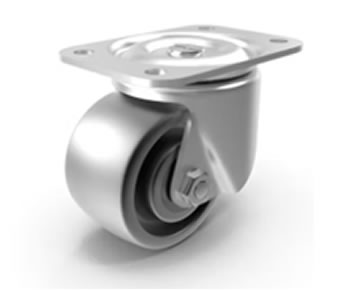Locking Casters
Locking casters, also known as locking wheels or caster brakes, are a specialized type of caster designed to provide both mobility and the ability to secure objects in place when needed. These casters are equipped with mechanisms that allow users to immobilize the wheels, preventing unintended movement. Locking casters are widely used in various applications where stability and safety are paramount.
Features of Locking Casters
Locking casters possess distinct features that make them valuable in many settings:
- Wheel Lock Mechanism: The primary feature of locking casters is the wheel lock mechanism. When engaged, this mechanism prevents the caster from rolling or swiveling, keeping the object or equipment stationary.
- Swivel Capability: Most locking casters are designed as swivel casters, meaning they can rotate 360 degrees for easy maneuverability when the locks are disengaged.
- Foot-Activated Locks: Many locking casters have foot-activated locks, allowing users to easily engage or disengage the wheel locks without bending down or using their hands.
- Durable Construction: Locking casters are typically built with durability in mind, as they often support heavy loads and are used in various industrial and commercial applications.
Applications of Locking Casters
Locking casters find application in a wide range of industries and settings where mobility and stability are essential:
- Medical Equipment: Hospital beds, medical carts, and diagnostic equipment often use locking casters to ensure stability during procedures and to prevent equipment from moving when not in use.
- Industrial Carts: Industrial and warehouse carts equipped with locking casters allow workers to secure loads during transport and when loading and unloading items.
- Office Furniture: Office chairs and furniture with locking casters offer mobility when needed and stability when sitting or working at a desk.
- Retail Displays: Retailers use locking casters for display units, ensuring that promotional displays and merchandise remain stationary.
- Material Handling: Locking casters are valuable in material handling equipment, such as dollies and hand trucks, for safe loading and unloading.
Advantages of Locking Casters
Locking casters offer several advantages in various applications:
- Stability: The ability to lock the wheels provides stability, preventing accidental movement and enhancing safety.
- Flexibility: Locking casters combine mobility and stability, allowing users to move objects when needed and lock them in place when required.
- Easy to Use: Foot-activated locks make it convenient for users to engage or disengage the wheel locks quickly and without much effort.
- Load Support: Locking casters are often designed to support heavy loads, making them suitable for various industrial and medical applications.
Considerations When Using Locking Casters
While locking casters offer significant advantages, there are some considerations to keep in mind:
- Proper Use: Ensure that locking casters are used correctly and that the locks are engaged when needed to prevent accidents or unintended movement.
- Wheel Material: Consider the type of wheel material based on the flooring and load requirements to prevent floor damage and ensure smooth rolling.
Locking casters provide a valuable solution for applications where both mobility and stability are essential. Understanding their features and applications can help you make informed decisions when selecting casters for your specific needs.










